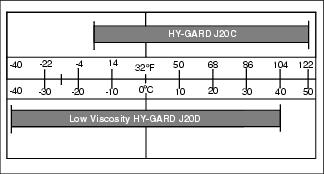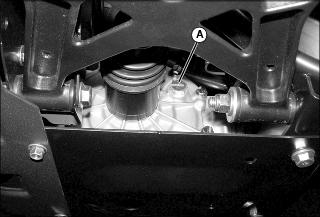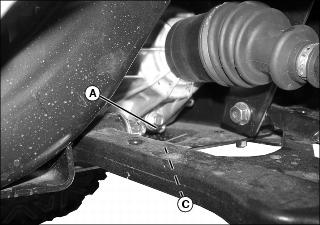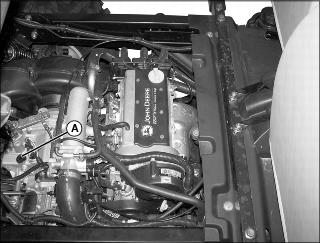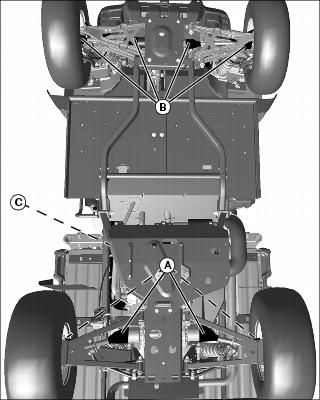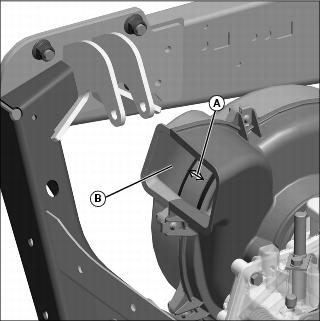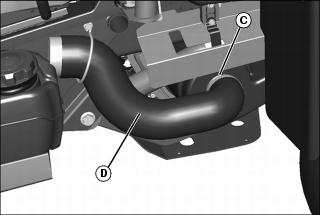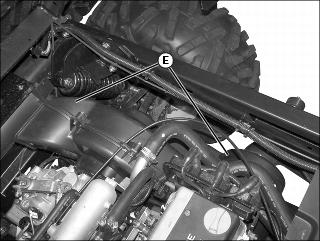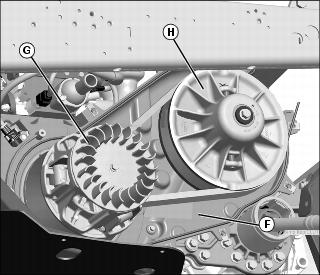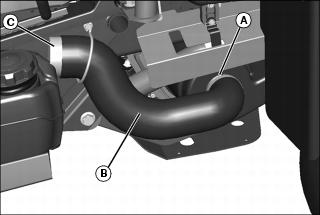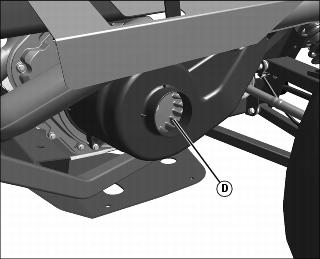
Service Transmission
Transaxle Oil
Use the appropriate oil viscosity based on these air temperature ranges. Operating outside of these recommended oil air temperature ranges may cause premature hydrostatic transmission or hydraulic system failures.
John Deere J20C HY-GARD transmission and hydraulic oil is recommended. John Deere J20D Low Viscosity HY-GARD transmission and hydraulic oil may be used, if within the specified temperature range.
Other oils may be used if above recommended John Deere oils are not available, provided they meet one of the following specifications:
4WD Front Differential Oil
Use the appropriate oil viscosity based on these air temperature ranges. Operating outside of these recommended oil air temperature ranges may cause premature hydrostatic transmission or hydraulic system failures.
John Deere J20D Low Viscosity HY-GARD transmission and hydraulic oil is recommended.
Other oils may be used if above recommended John Deere oils are not available, provided they meet the following specifications:
Checking 4WD Front Differential Oil Level
1. Park machine safely. (See Parking Safely in the SAFETY section.) Allow machine to cool down for at least one hour.
IMPORTANT: Avoid damage! Dirt and debris in oil may cause damage to the 4WD differential. Clean area around opening before removing plug. |
Picture Note: Fill plug under under left front side.
2. Remove fill plug (A) located on left side of 4WD front differential.
3. Oil should be level with the bottom of the fill port. If oil level is low:
a. Add oil through fill port until level is correct.
b. Install and tighten fill plug to 11 - 40 Nm (8 - 30 lb-ft).
Changing 4WD Front Differential Oil
NOTE: It may be necessary to remove front skid plate to access drain plug.
1. Operate machine to warm 4WD front differential oil.
2. Park machine safely. (See Parking Safely in the SAFETY section.)
IMPORTANT: Avoid damage! Dirt and debris in oil may cause damage to the 4WD differential. Clean area around opening before removing plug. |
Picture Note: Drain plug under right front side.
Picture Note: Fill plug under left front side.
3. Position drain pan under 4WD front differential drain plug (A) at bottom right of housing.
4. Remove fill plug (B) located on left side of 4WD front differential.
5. Remove 4WD front differential drain plug (A) and allow oil to drain through opening (C) in frame and into drain pan.
6. Check washer on drain plug. Replace if missing or in poor condition.
7. Install and tighten drain plug to 7-14 Nm (5-10 lb-ft) after all oil has drained.
8. Add oil until the level is even with the bottom of the fill port.
9. Install and tighten fill plug to 11-40 Nm (8-30 lb-ft).
10. Check 4WD front differential oil level again after the first several hours of operation.
Checking Transaxle Oil Level
IMPORTANT: Avoid damage! Hot hydraulic oil will expand and show incorrect oil level. Check oil level: |
1. Park the vehicle safely. (See Parking Safely in the SAFETY section.)
2. Raise and secure cargo box.
IMPORTANT: Avoid damage! Dirt and debris in oil may cause damage to the transaxle. Clean area around opening before removing dipstick. |
3. Remove dipstick (A) located on the top of the transaxle housing. Wipe dipstick clean.
4. Check oil level by setting dipstick on threads in transaxle case, then removing and checking oil level.
5. Add oil as needed through the dipstick fill hole.
6. Install and tighten dipstick.
Changing Transaxle Oil
1. Park the vehicle safely. (See Parking Safely in the SAFETY section.)
2. Raise and secure cargo box.
IMPORTANT: Avoid damage! Dirt and debris in oil may cause damage to the transaxle. Clean area around opening before removing dipstick. |
3. Position drain pan under transaxle drain plug (A).
5. Check washer on drain plug. Replace if missing or in poor condition.
6. Install and tighten drain plug to 44 - 54 Nm (32.5 - 39.9 lb-ft).
7. Remove dipstick located on top of transaxle housing. Wipe dipstick clean.
9. Check oil level by setting dipstick on threads in transaxle case, then removing and checking oil level.
10. Wait for two minutes then check oil level. Add oil if necessary.
11. Install dipstick and tighten.
Inspecting Driveline CV Boots
1. Park the vehicle safely. (See Parking Safely in the SAFETY section.)
Picture Note: Viewed from under the machine.
2. Inspect four rear CV boots (A) for tears or punctures.
3. Inspect four front CV boots (B) for tears or punctures. Repeat for opposite side of machine.
4. Inspect rear drive shaft boot (C) for tears or punctures.
5. If replacement of a boot is necessary, see your John Deere dealer.
Checking Drive Belt
1. Park the vehicle safely. (See Parking Safely in the SAFETY section.)
2. Raise and secure cargo box.
NOTE: Drive belt can be inspected through enclosure exhaust port (B) with out removing clutch enclosure cover.
3. Measure the top surface of the belt width at (A). Dimension should be a minimum of 29 mm (1.1 in.).
4. Check inside enclosure exhaust port (B) for debris.
5. If debris is found inside exhaust port, loosen clamp (C) and remove air inlet hose (D).
NOTE: Since there are two bolts longer than the rest, be sure to note which bolts came from which holes when removing clutch enclosure cover.
6. Remove eleven bolts and outer clutch enclosure cover (E).
7. Clean inside clutch enclosure cover, clutch enclosure base (F), and around drive (G) and driven clutch (H) assemblies.
8. Rotate and inspect belt for wear or damage.
9. If replacement of belt is necessary, see your John Deere dealer.
10. Install outer clutch enclosure cover, and secure with eleven bolts.
11. Install air inlet hose and secure with hose clamp.
Cleaning Primary Drive Clutch
1. Park the vehicle safely. (See Parking Safely in the SAFETY section.)
2. Raise and secure cargo box.
3. Under left side of vehicle, remove hose clamp (A) and pull air intake hose (B) off of outer clutch cover.
4. Remove foam filter (C) from air intake hose. Clean filter and allow to dry.
5. Through access hole (D), use compressed air to blow dust and debris out of clutch fan area.
6. Install foam filter into air intake hose and install hose back onto outer clutch cover with clamp.
